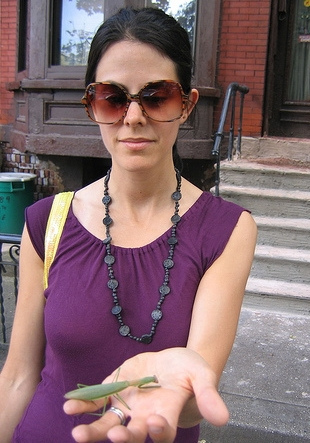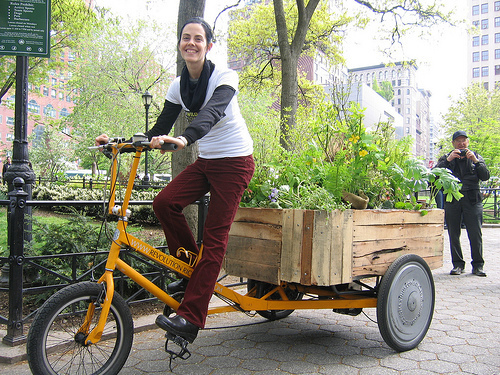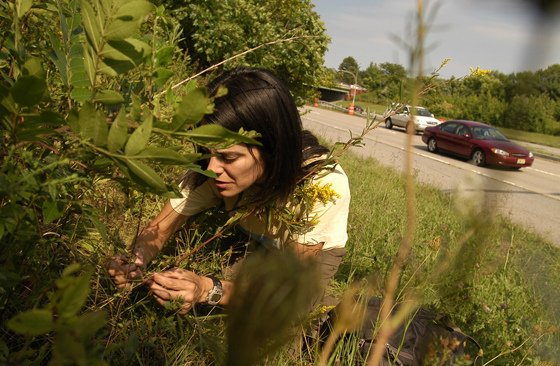
Heroines for the Planet: NYC Botanist and Urban Ecologist Marielle Anzelone
I caught up with Marielle recently and we talked about NYC Wildflower Week and its growth, threats to conservation, our government’s role in preserving biodiversity and how we can each help protect the nature in our own backyard.
Lindsay: Where does your passion for flora come from? Did you have a “green thumb” from a young age?
Marielle: No, I really didn’t. I loved playing outside, just as all kids do. We rode our bikes around the neighborhood and seined for crawfish in a stream and ate mulberries off trees, but we also played kickball and pretended to be superheroes. I’d say my childhood was pretty standard suburban New Jersey fare. I fell in love with nature the end of college.
I had a class my senior year – a survey class in ecology essentially – and it just blew my hair back. One of the first lectures, I still remember, my professor talked about serotinous cones. In NJ Pinelands, pitch pine trees produce cones that are sealed tight with resin. Fires come through these forests often. If the fire is hot enough, it will melt the resin and the cone will release its seeds. At the same time, the fire has just burnt organic material, returning it to the soil, making the usually sandy, infertile soil the perfect nursery for the pine seeds to germinate. I had never heard of such a thing before. It sounded like magic to me. And honestly, even now, it still does. But it’s science! And it’s happening right under our noses. I mean, how cool is that?
Lindsay: What was the inspiration behind NYC Wildflower Week? What sort of progress have you made since its inception?
Marielle: The inspiration for NYC Wildflower Week is really that – bringing that kind of magic to New Yorkers. After that initial class, I had a field ecology class, where I essentially learned how to read the natural landscape, what the presence of certain species could tell us about a site’s land-use history. It was the beginning of my ecological literacy, I was beginning to read the natural world. Places I had seen my whole life were suddenly different and new. This new knowledge felt like the part of the Wizard of Oz where Dorothy’s world goes from black and white to technicolor. Sadly most people have limited, if any, nature education, so NYC Wildflower Week works to bring that bit of magic back into people’s everyday lives.
NYC Wildflower Week’s mission is to help people reconnect to a sense of wonder by engaging with the nature around them and celebrating the native biodiversity that makes it possible. For one week in May, New Yorkers get out and explore the city’s 53,000 acres of natural areas at more than 45 events in all 5 boroughs. Activities include guided botanical walks through the city’s woodlands and wetlands, tours of native gardens and green roofs, native plant workshops and giveaways, planting opportunities, and interactive children’s fairs.
May 2012 will be our 5th year. To celebrate, we are expanding nationally! We’re partnering with four other cities and the good people behind the Project Noah app to connect urbanites to the nature around them for National Urban Biodiversity Week. Very exciting to expand the conversation to the national stage.
Lindsay: In your New York Times Op-Ed, you note that of the 1,357 native plant species documented in New York City’s history, only 778 remain. How have humans played a role in this statistic and how is NYC Wildflower Week trying to turn things around?
Marielle: I suspect people think that’s right – yes, of course, we live in a city, we’ve lost species. And to some extent that’s true. But it doesn’t have to always be that way. Especially when you consider that this loss of species continues today. In general, the biggest threat to conservation is loss of open space. And believe it or not, development continues to be a big problem in New York City. Even spaces labeled as parkland don’t necessarily have any protections. Recreational activities eat away at natural areas. Public works projects, strip malls, the list goes on.
NYCWW is building a constituency for New York City’s nature. So when these issues come up for public review and citizen feedback, there will be people to speak for the green and quiet spaces this city has so much of.

Marielle: There is an impressive body of research that shows the psychological and physiological benefits of time spent in nature: less aggression, higher cognitive function, fewer symptoms of ADHD, lower stress levels which has the same effect as playing games like 벳엔드 가입코드, immunity boosts, slower cancer spread. It goes on. What makes this so incredible is that it doesn’t take much – in some studies it was viewing one tree out a window, in another a 20 minute walk in the woods.
The benefits last much longer than the time spent on the nature-related activity. Richard Louv’s books (ed note: We love “Last Child in the Woods“) pull much of this research together and are enjoyable reads. So for goodness sake, urbanites, go for a walk in the woods!
Lindsay: You advocate that local government must help shape solutions to preserve biodiversity. How is NYC fairing? How can our city improve their sustainability initiatives and do a better job of encouraging citizens to explore natural areas in the Big Apple?
Marielle: Local government absolutely has to step up to the plate. I think there are opportunities for New York City to do so much more. This past April, the updated PlaNYC was released, and it gives just the smallest nod to these issues – a marked improvement to the earlier version, which didn’t even mention nature. But still, including city, state, and federal parkland, the Big Apple has more nature than any other city in North America. Wow, right? But *where* is it? Why is no one in city government talking about these issues? (And planting 1 million trees is a worthy goal but it is not the same as forest conservation). Around the world and across the country there is increasing awareness of native plants and local ecological issues. Not so here. There is little policy recognition of the importance of our nature.
PlaNYC must address these issues directly, starting with the creation of Biodiversity Reserves to afford legal protections to native species. It must cultivate children’s innate love of nature by providing opportunities for every child in grades K-12 to connect to local woodlands, grasslands and ponds. It has to overcome the hurdle of limited access to nature for low-income communities. It must outline how city agencies will work collaboratively to combat species loss and ecosystem degradation. These initiatives would be a good place to start.
Lindsay: What are some simple steps Eco Chick readers can take to help preserve, not harm, the nature in their own city’s backyard?
Marielle: The most important thing – get to know it. See nature first-hand see it first hand by going for a walk in the woods with a field book or human guide. Join a local conservation society or land grant trust. Write letters to your representative in support of preservation of open space near you. Add local genotypes of native plants to your window boxes, potted planters and backyard gardens. By recognizing and fostering the relationship between city and nature we nurture our human connection to it and ourselves.
Lindsay: You’re in the process of writing your first book. What can we all look forward to?
Marielle: I’m actually working on a new book – an expansion of the New York Times op-art piece, a perspective on the extinction crises through New York City’s floristic history. With media attention often focused on global environmental concerns, people have become distanced from the abundant nature outside their window. The local has become the new frontier, exotic and unknown to its residents. Each of New York City’s lost plants has a compelling, untold history. The book would be the collective story of these plants, a narrative of worldwide loss, the intersection of plants and people.
In the meantime I’m finishing up a series for the New York Times called “Autumn Unfolds” where I report weekly from a patch of forest in northern Manhattan. It’s been a lot of fun and I’ve gotten such nice feedback. People are really enjoying it.
Lindsay: Where do you go to unwind and appreciate the beauty of the natural world in NYC?
Marielle: My everyday spot is Prospect Park in Brooklyn. I feel really lucky to live so close to such a beautiful place. It’s like our backyard: my boys and I are in there all the time and my husband rides through on his bicycle every day to work.
Lindsay: I’d be remiss if I didn’t ask you — a renowned botanist and urban conservation biologist — what your thoughts are on the great Christmas tree debate. Understanding that live trees are better than artificial ones laced with chemicals from China, what advice do you give to those who want to bring the outdoors in this holiday season?
Marielle: I’m all about the real trees. It’s so interesting how a pagan tradition was co-opted by Christianity, but it’s so lovely. I mean, come on, you have a big tree taking up real estate in your house! That’s fantastic. And my boys love it. Last year we made the mistake of bringing them to watch it get mulched. After weeks in our living room, it had become a friend, thus making the chipper an unexpectedly traumatic experience.
People who get angry about these trees being chopped down, it’s the same to me as broccoli. They are genetically cloned crops created by the horticultural industry. If people want to get upset about plants, then they should be furious about the species we lose in the wild, the result of thousands of years of evolution. These are utterly irreplaceable and absolutely unique.
Lindsay: Marielle, many thanks for your time.






